The Seventeenth-century Canal Ring Area of Amsterdam inside the Singelgracht: Amsterdam is the capital city of the Netherlands. The 17th century canal ring area of Amsterdam inside the Singelgracht was built during the Dutch 'Golden Age' when the village became one of the most important ports in the world. The canal ring area of Amsterdam is a network of canals around the historic centre of Amsterdam. The canals were dug to drain the swampland, the unique 17th century canal houses were built on the drained land. The canal ring area is a good example of Dutch urban development in the 17th century and was the largest urban extension of its time. The House of Anne Frank is situated inside the canal ring of Amsterdam at the Prinsengracht 263-267, here she was hiding in Het Achterhuis during WWII to escape the Nazis, who invaded the Netherlands in 1940. Here she wrote her diaries. The Diaries of Anne Frank are inscribed on the UNESCO Memory of the World List. The Library Ets Haim is housed in the 17th century Portuguese Synagogue. The Library Ets Haim was also inscribed on the UNESCO Memory of the World List. The famous Dutch painter Rembrandt is probably buried in the Westerkerk (West Church), the church was built by the Dutch architect Hendrick de Keyser. Amsterdam is often called the 'Venice of the North', comparing the city to Venice, because there are over 100 km of canals, about 90 islands and more than 1200 bridges. The Defense Line of Amsterdam is a ring of fortifications around the city. The Seventeenth-century Canal Ring Area of Amsterdam inside the Singelgracht gained the status as a UNESCO World Heritage in 2010. World Heritage Art: Anne Frank and Amsterdam Canal Houses
www.werelderfgoedfotos.nl © Copyright World Heritage Photos

Canal Ring Area of Amsterdam inside the Singelgracht: The Spiegelgracht, the Mirror Canal. The Spiegelgracht is situated close to the Rijksmuseum and the Van Gogh Museum. Amsterdam is often called the 'Venice of the North', because there are more than 100 km of canals, about 90 islands and 1500 bridges. The three main 17th century canals of the Amsterdam canal area are: Herengracht, Keizersgracht and Prinsengracht.
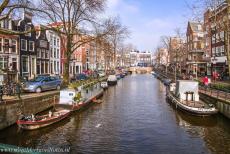
Canal Ring Area of Amsterdam inside the Singelgracht: The Spiegelgracht, the Mirror Canal. The Spiegelgracht is situated close to the Rijksmuseum and the Van Gogh Museum. Amsterdam is often called the 'Venice of the North', because there are more than 100 km of canals, about 90 islands and 1500 bridges. The three main 17th century canals of the Amsterdam canal area are: Herengracht, Keizersgracht and Prinsengracht.
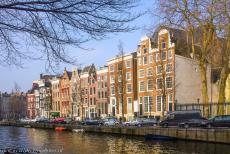
Seventeenth-century Canal Ring Area of Amsterdam inside the Singelgracht: The Golden Bend is a stretch of the Herengracht and is the most prestigious part of the 17th century canal ring area. The Golden Bend is famous for its most imposing and expensive 17th century canal houses. The Seventeenth-century Canal Ring Area of Amsterdam inside the Singelgracht gained the status as a UNESCO World Heritage in 2010.
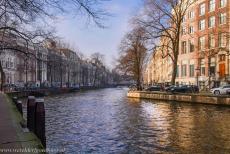
Seventeenth-century Canal ring area of Amsterdam: The Golden Bend in the Herengracht. The canal houses along the Golden Bend are a symbol of prosperity of the Netherlands in the 17th century. The houses were built twice the width of an average canal house, with steps on both sides of the front door. The 17th century Canal Ring of Amsterdam was built during the Dutch Golden Age when the small village became one of the major ports in the world.

Seventeenth-century Canal ring area of Amsterdam inside the Singelgracht: An arched stone bridge over the Keizersgracht, one of the main canals. The Singel is the innermost canal, it was dug in the 15th century. The Herengracht, the Keizersgracht and Prinsengracht, the other main canals, were dug in the 17th century. The main canals were intersected with radial canals. The outermost boundary of the canal ring is the Singelgracht.
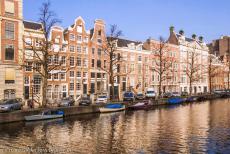
The 17th century Canal ring area of Amsterdam inside the Singelgracht: The traditional Dutch canal houses along the Keizersgracht. The 17th century canal houses were built tall and skinny, to save on taxes, taxes were based on the width of the façade. The smallest canal house is 2.2 metres wide and 6 metres deep, the house is situated on the Oude Hoofdstraat. The house with the narrowest façade is situated at Singel 7, it is actually the rear façade, the frontage is wider.
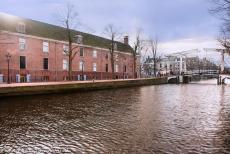
Canal Ring Area of Amsterdam inside the Singelgracht: The Walter Süskind drawbridge next to the H'ART Museum, the former Hermitage Amsterdam. The H'ART Museum is situated in a monumental building, called Amstelhof. The Amstelhof was built in 1683 and served as a home for elderly people. Nowadays, it houses the H'ART Museum. The H'ART Museum, is situated on the Nieuwe Prinsengracht.
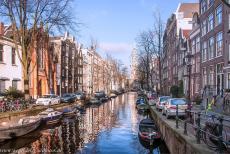
The Seventeenth-century Canal ring area of Amsterdam: The 9 Little Streets, De 9 Straatjes, is a popular area in Amsterdam, named after the nine little streets connecting the main canals from the Singel to the Prinsengracht, crossing the Herengracht and Keizersgracht. The 17th century Jordaan district, the Royal Palace on the Dam, the Anne Frank House and the Westerkerk (West Church) with its famous tower are situated nearby the 9 Little Streets.
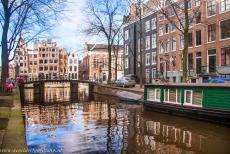
Canal Ring Area of Amsterdam: A houseboat in one of the canals of Amsterdam. Many people in Amsterdam are living on a houseboat. After World War II, houseboats were used to solve the severe problem of housing shortage. Nowadays, it is very expensive to live on a houseboat, due to the limited number of moorings. There are around 2500 houseboats in Amsterdam. Many of these houseboats are more than a hundred years old.
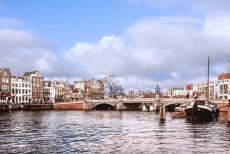
The Blauwbrug, the Blue Bridge, is spanning the river Amstel. The Blauwbrug was built in 1884 and replaced a 17th century wooden bridge, which was painted blue, one of the colours of the Dutch flag. The present Blauwbrug was inspired by the Pont Alexander III, a bridge in Paris. The Blauwbrug is adorned with nautical carvings and lanterns. The Blauwbrug is situated near the City Hall and the H'ART Museum, the former Hermitage Amsterdam, inside the canal ring area of Amsterdam.
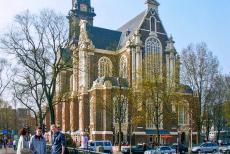
The 17th century Canal ring area of Amsterdam inside the Singelgracht: The Westerkerk (West Church) was built by the Dutch architect Hendrick de Keyser. The Westerkerk was completed in 1631, the 85 metres high tower houses a 47 bell carillon. The famous Dutch painter Rembrandt is probably buried here, the location of his grave is unknown. The Westerkerk is situated close to the Anne Frank House, Anne Frank mentioned the tower of the church in her diary.

Canal ring area of Amsterdam inside the Singelgracht: The House of Anne Frank is situated at the Prinsengracht 263-267 in Amsterdam. During World War II, here Anne Frank and her family were hiding in Het Achterhuis, a hiding place to escape the Nazis, who invaded the Netherlands in 1940. Here, Anne Frank wrote her diary. Anne Frank died in Nazi concentration camp Bergen-Belsen, she was just fifteen years old. Her diary is one of the most famous books in history.
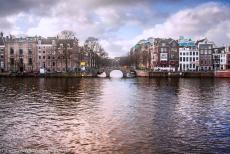
Amsterdam is worldwide famous for its canals and canal houses. The first canal houses in the canal ring area of Amsterdam were built in 1615. The canal houses are narrow, high and deep. The canal houses are facing the canals. The Amsterdam canals and canal houses are unique in the world. The canal ring area of Amsterdam inside the Singelgracht is an excellent example of Dutch urban development in the 17th century and was the largest urban extension of its time.
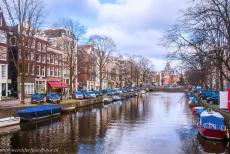
The 17th century canal ring area of Amsterdam inside the Singelgracht was constructed during the Dutch Golden Age when the small village became one of the most important ports in the world. The canal ring area of Amsterdam is a network of canals around the historic centre of the city of Amsterdam. The canals were dug to drain the swampland. The unique 17th century canal houses were built on the drained land.
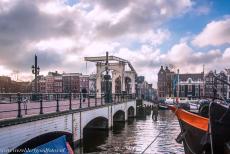
Seventeenth-century Canal Ring Area of Amsterdam inside the Singelgracht: The Magere Brug (Skinny Bridge) is one of the most famous bridges of Amsterdam. The Magere Brug is a wooden drawbridge, it only carries pedestrians and cyclists, the Magere Brug was first built in 1691 and completely rebuilt several times, the last time in 1934. The Magere Brug is spanning the Amstel River. Amsterdam has eight drawbridges.
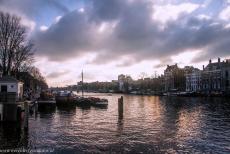
Dark clouds looming over the canals of Amsterdam. Amsterdam is situated inside the imposing Defence Line of Amsterdam, a 135 km long ring of 45 fortifications, batteries and waterworks around the capital city of the Netherlands. The Defence Line of Amsterdam is also an UNESCO World Heritage. The Seventeenth-century Canal ring area of Amsterdam inside the Singelgracht was inscribed on the UNESCO World Heritage List in 2010.
